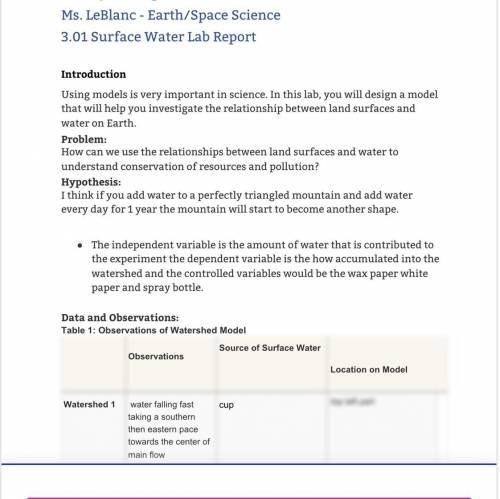Surface Water Lab Report
Introduction
Using models is very important in science. In this lab,...

Surface Water Lab Report
Introduction
Using models is very important in science. In this lab, you will design a model that will help you investigate the relationship between land surfaces and water on Earth.
Problem:
How can we use the relationships between land surfaces and water to understand conservation of resources and pollution?
Hypothesis:
After completing steps 1 through 5 in your procedures, predict the number and locations of watersheds that will form in your watershed model.
For example:
Based on the positions of landscape features in my watershed model, I predict there will be ___3 number of watersheds located at these locations in my model: close to the top, in the center, and the right side.
Materials:
If you would like to create your watershed model by hand, you will need the materials listed.
Note: There are alternative procedures that do not require these materials.
one sheet of plain white paper
several sheets of old newspaper, or wax paper if available
one water-based marker (Note: do not use permanent marker)
one spray bottle containing water (place on “mist” setting)
digital camera, if available
Procedures:
Place several sheets of newspaper or wax paper over a large flat surface, such as a kitchen counter. Use at least five sheets of paper so that you can protect your work area.
Crumple the sheet of white paper into a loose wad.
Uncrumple the sheet of paper so you can lay it on your work surface. The paper should not be flat but should be wrinkled and puffed up from the crumpling.
Imagine the paper as a miniaturized version of mountains, hills, valleys, and other landscape features. If your paper is so flat that you can't imagine these features, you should recrumple it.
Use the marker to color the major folds or ridges in the paper, as well as some of the minor folds or ridges. Do not allow the marker to color any other part of the paper.
Place the paper on top of the newspaper on the counter, and then lightly mist the piece of paper with the spray bottle. Don't spray too heavily: Three to seven squirts will probably do the job.
Stop misting as soon as you see some of the colored water starting to collect in some of the valleys. Watch for a few moments as stream patterns develop over the paper.
If you have access to a digital camera, take a photograph of your work and include it in your Data and Observations.
Record your observations of each watershed that forms in Table 1. Take note of headwaters, channels, divides, tributaries, mouths, floodplains, precipitation, and infiltration in your descriptions.
Complete the Questions and Conclusion section of the lab report.
Procedures without materials:
Use the video demonstration of a watershed model linked on the lesson assessment page to complete the information below and answer the questions.
Variables:
For this investigation
List the independent variable(s):
List the dependent variable(s):
List the controlled variable(s):
Data and Observations:
If you were able to take a photograph of your paper, or a screenshot of the demonstration, include a copy of this photo and label each of your watersheds in the model.
Table 1: Observations of Watershed Model
Questions and Conclusion
View the surface water animation clip of the Mississippi watershed in the lesson. Compare what is happening in this animation to what occurred to your watershed model.
Identify and describe all the ways water moved in your watershed model. Be sure to include headwaters, channels, divides, tributaries, mouth, floodplains, precipitation, and infiltration in your description.
How many different watersheds were in your model? How were you able to identify them?
Earth’s landscape can change over time. What can happen to a watershed as a result?
Based on what you observed in the lab, why does pollution become more than a local problem?
In conclusion, how did your prediction of watershed locations match the watersheds in your model?
In what ways could you continue to investigate the behavior of surface water and the creation of watersheds? How would further investigation provide research for strategies to solve the spread of water pollution?

Answers: 3


Another question on Biology

Biology, 22.06.2019 02:00
The idea of spontaneous generation was disproved by in a experiment involving jars of meat
Answers: 1

Biology, 22.06.2019 04:30
African penguins, which inhabit the coasts of southern africa, were classified as an endangered species in 2010. two significant threats to their survival are ecosystem damage from oil spills and overfishing by humans. overfishing depletes the food supply of african penguins. the best method to reduce the threat of overfishing would be to . the risk of oil spills could be reduced by increasing the use of , which should oil consumption. if an oil spill does occur, could be used to remove the oil so the ecosystem may more quickly recover.
Answers: 2

Biology, 22.06.2019 15:00
Which of the following organisms are capable of self-fertilization? a.plants b.tigers c.humans
Answers: 2

Biology, 22.06.2019 20:20
How is anaerobic respiration affected by changes in temperature? (5 points)based on the conditions of early earth, what conclusion can you draw about the amount of anaerobic respiration that was occurring at earth’s beginning? explain your answer.(5 points)if there was a sudden drop in temperature after the evolution of the first living cells, predict how that might have affected the changes in the atmosphere and the evolution of cyanobacteria and other autotrophs. explain your answer. (5 points)
Answers: 1
You know the right answer?
Questions


History, 05.05.2020 03:57

Geography, 05.05.2020 03:57


Physics, 05.05.2020 03:57

English, 05.05.2020 03:57


English, 05.05.2020 03:57


Mathematics, 05.05.2020 03:57

Mathematics, 05.05.2020 03:57


History, 05.05.2020 03:57




Computers and Technology, 05.05.2020 03:57

History, 05.05.2020 03:57





